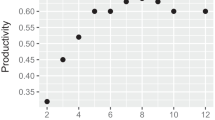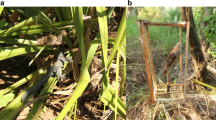Abstract
Kin selection has played an important role in the evolution and maintenance of cooperative breeding behaviour in many bird species. However, although relatedness has been shown to affect the investment decisions of helpers in such systems, less is known about the role that kin discrimination plays in other contexts, such as communal roosting. Individuals that roost communally benefit from reduced overnight heat loss, but the exact benefit derived depends on an individual's position in the roost which in turn is likely to be influenced by its position in its flock's dominance hierarchy. We studied the effects of kinship and other factors (sex, age, body size and flock sex ratio) on an individual's roosting position and dominance status in captive flocks of cooperatively breeding long-tailed tits Aegithalos caudatus. We found that overall, kinship had little influence on either variable tested; kinship had no effect on a bird's position in its flock's dominance hierarchy and the effect of kinship on roosting position was dependent on the bird's size. Males were generally dominant over females and birds were more likely to occupy preferred roosting positions if they were male, old and of high status. In this context, the effect of kinship on social interactions appears to be less important than the effects of other factors, possibly due to the complex kin structure of winter flocks compared to breeding groups.

Similar content being viewed by others
References
Adams AAY, Skagen SK, Knight RL (2000) Functions of perch relocations in a communal night roost of wintering bald eagles. Can J Zool 78:809–816
Austad SN, Rabenold KN (1985) Reproductive enhancement by helpers and an experimental inquiry into its mechanism in the bicolored wren. Behav Ecol Sociobiol 17:19–27
Barton K (2012) MuMIn: multi-model inference. R package version 1.7.11. http://cran.r-project.org/web/packages/MuMIn/index.html. Accessed 22 August 2012
Bates D, Maechler M (2010) lme4: linear mixed effect models using S4 classes. R package version 0.999375-37. http://lme4.r-forge.r-project.org/. Accessed 20 January 2011
Beauchamp G (1999) The evolution of communal roosting in birds: origin and secondary losses. Behav Ecol 10:675–687
Bijleveld AI, Folmer EO, Piersma T (2012) Experimental evidence for cryptic interference among socially foraging shorebirds. Behav Ecol 23:806–814
Bishop RP, Groves AL (1991) The social structure of Arabian babbler, Turdoides squamiceps, roosts. Anim Behav 42:323–325
Burnham KP, Anderson DR (2002) Model selection and multi-model inference: a practical information-theoretic approach, 2nd edn. Springer, New York
Calf K, Adams N, Slotow R (2002) Dominance and huddling behaviour in bronze mannikin Lonchura cucullata flocks. IBIS 144:488–493
Chaplin SB (1982) The energetic significance of huddling behavior in common bushtits (Psaltriparus minimus). Auk 99:424–430
Covas R, Griesser M (2007) Life-history and the evolution of family living in birds. Proc R Soc Lond B 274:1349–1357
Covas R, Dalecky A, Caizergues A, Doutrelant C (2006) Kin associations and direct vs. indirect fitness benefits in colonial cooperatively breeding sociable weavers Philetairus socius. Behav Ecol Sociobiol 60:323–331
Dickinson JL (2004) A test of the importance of direct and indirect fitness benefits for helping decisions in western bluebirds. Behav Ecol 15:233–238
Dickinson JL, Euaparadorn M, Greenwald K, Mitra C, Shizuka D (2009) Cooperation and competition: nepotistic tolerance and intrasexual aggression in western bluebird winter groups. Anim Behav 77:867–872
Donázar JA, Feijóo JE (2002) Social structure of Andean Condor roosts: influence of sex, age, and season. Condor 104:832–837
du Plessis MA (2004) Physiological ecology. In: Koenig WD, Dickinson JL (eds) Ecology and evolution of cooperative breeding in birds. Cambridge University Press, Cambridge, pp 117–126
du Plessis MA, Weathers WW, Koenig WD (1994) Energetic benefits of communal roosting by acorn woodpeckers during the non-breeding season. Condor 96:631–637
Eiserer LA (1984) Communal roosting in birds. Bird Behav 5:61–80
Ekman J, Dickinson JL, Hatchwell BJ, Griesser M (2004) Delayed dispersal. In: Koenig WD, Dickinson JL (eds) Ecology and evolution of cooperative breeding in birds. Cambridge University Press, Cambridge, pp 35–47
Feare CJ, Gill EL, McKay HV, Bishop JD (1995) Is the distribution of starlings Sturnus vulgaris within roosts determined by competition? IBIS 137:379–382
Gaston AJ (1977) Social behaviour within groups of jungle babblers (Turdoides striatus). Anim Behav 25:828–848
Gelman A, Su Y-S, Yajima M, Hill J, Pittau MG, Kerman J, Zheng T (2012) arm: data analysis using regression and multilevel/hierarchical models. R package, version 1.5-05. http://cran.r-project.org/web/packages/arm. Accessed 22 August 2012
Griesser M, Ekman J (2005) Nepotistic mobbing behaviour in the Siberian jay, Perisoreus infaustus. Anim Behav 69:345–352
Griesser M, Nystrand M, Eggers S, Ekman J (2008) Social constraints limit dispersal and settlement decisions in a group-living bird species. Behav Ecol 19:317–324
Griffiths R, Double MC, Orr K, Dawson DA (1998) A DNA test to sex most birds. Mol Ecol 7:1071–1075
Hamilton WD (1964) The genetical evolution of social behaviour. J Theor Biol 7:1–52
Hardy OJ, Vekemans X (2002) SPAGeDi: a versatile computer program to analyse spatial genetic structure at the individual or population levels. Mol Ecol Notes 2:618–620
Hatchwell BJ, Anderson C, Ross DJ, Fowlie MK, Blackwell PG (2001) Social organization of cooperatively breeding long-tailed tits: kinship and spatial dynamics. J Anim Ecol 70:820–830
Hatchwell BJ, Russell AF, MacColl ADC, Ross DJ, Fowlie MK, McGowan A (2004) Helpers increase long-term but not short-term productivity in cooperatively breeding long-tailed tits. Behav Ecol 15:1–10
Hatchwell BJ, Sharp SP, Simeoni M, McGowan A (2009) Factors influencing overnight loss of body mass in the communal roosts of a social bird. Funct Ecol 23:367–372
Hoogland JL (1983) Nepotism and alarm calling in the black-tailed prairie dog (Cynomys ludovicianus). Anim Behav 31:472–479
Jenni L (1993) Structure of a brambling Fringilla montifringilla roost according to sex, age and body-mass. IBIS 135:85–90
Kaib M, Husseneder C, Epplen C, Epplen JT, Brandl R (1996) Kin-biased foraging in a termite. Proc R Soc Lond B 263:1527–1532
Krause J, Ruxton GD (2002) Living in groups. Oxford University Press, Oxford
Ligon JD, Carey C, Ligon SH (1988) Cavity roosting, philopatry, and cooperative breeding in the green woodhoopoe may reflect a physiological trait. Auk 105:123–127
MacColl ADC, Hatchwell BJ (2004) Determinants of lifetime fitness in a cooperative breeder, the long-tailed tit Aegithalos caudatus. J Anim Ecol 73:1137–1148
Maynard Smith J (1964) Group selection and kin selection. Nature 201:1145–1147
McGowan A (2002) Fitness benefits of helping in the long-tailed tit Aegithalos caudatus. PhD thesis, University of Sheffield
McGowan A, Hatchwell BJ, Woodburn RJ (2003) The effect of helping behaviour on the survival of juvenile and adult long-tailed tits Aegithalos caudatus. J Anim Ecol 72:491–499
McGowan A, Sharp SP, Simeoni M, Hatchwell BJ (2006) Competing for position in the communal roosts of long-tailed tits. Anim Behav 72:1035–1043
McGowan A, Fowlie MK, Ross DJ, Hatchwell BJ (2007) Social organization of cooperatively breeding long-tailed tits Aegithalos caudatus: flock composition and kinship. IBIS 149:170–174
McKechnie AE, Lovegrove BG (2001) Thermoregulation and the energetic significance of clustering behaviour in the white-backed mousebird (Colius colius). Physiol Biochem Zool 74:238–249
Nam K-B, Simeoni M, Sharp SP, Hatchwell BJ (2010) Kinship affects investment by helpers in a cooperatively breeding bird. Proc R Soc Lond B 277:3299–3306
Nam K-B, Meade J, Hatchwell BJ (2011) Do parents and helpers adjust their provisioning effort in relation to nestling sex in a cooperatively breeding bird? Anim Behav 82:303–309
Noske RA (1985) Huddle-roosting behavior of the varied sittella, Daphoenositta chrysoptera, in relation to social-status. EMU 85:188–194
Queller DC, Goodnight KF (1989) Estimating relatedness using genetic markers. Evolution 43:258–275
R Development Core Team (2010) R: a language and environment for statistical computing. R foundation for statistical computing, Vienna
Redfern CPF, Clark JA (2001) Ringers' manual, 4th edn. BTO, Thetford
Richner H (1989) Phenotypic correlates of dominance in carrion crows and their effects on access to food. Anim Behav 38:606–612
Russell AF, Hatchwell BJ (2001) Experimental evidence for kin-biased helping in a cooperatively breeding vertebrate. Proc R Soc Lond B 268:2169–2174
Schielzeth H (2010) Simple means to improve the interpretability of regression coefficients. Methods Ecol Evol 1:103–113
Schuett GW (1997) Body size and agonistic experience affect dominance and mating success in male copperheads. Anim Behav 54:213–224
Sharp SP, McGowan A, Wood MJ, Hatchwell BJ (2005) Learned kin recognition cues in a social bird. Nature 437:1127–1130
Sharp SP, Simeoni M, Hatchwell BJ (2008) Dispersal of sibling coalitions promotes helping among immigrants in a cooperatively breeding bird. Proc R Soc Lond B 275:2125–2130
Sherman PW (1977) Nepotism and the evolution of alarm calls. Science 197:1246–1253
Simeoni M (2011) Inbreeding and inbreeding avoidance in the long-tailed tit (Aegithalos caudatus). PhD thesis, University of Sheffield
Simeoni M, Dawson DA, Ross DJ, Châline N, Burke TA, Hatchwell BJ (2007) Characterisation of 20 microsatellite loci in the long-tailed tit Aegithalos caudatus (Aegithalidae, AVES). Mol Ecol Notes 7:1319–1322
Stacey PB, Ligon JD (1991) The benefits of philopatry hypothesis of the evolution of cooperative breeding in birds: variation in territory quality and group size effects. Am Nat 137:831–846
Summers RW, Westlake GE, Feare CJ (1987) Differences in the ages, sexes and physical condition of starlings Sturnus vulgaris at the centre and periphery of roosts. IBIS 129:96–102
Swingland IR (1977) The special and social organization of winter communal roosting in rooks (Corvus frugilegus). J Zool 182:509–528
Tokarz RR (1985) Body size as a factor determining dominance in staged agonistic encounters between male brown anoles (Anolis sagrei). Anim Behav 33:746–753
Weatherhead PJ (1983) Two principal strategies in avian communal roosts. Am Nat 121:237–243
Weatherhead PJ, Hoysak DJ (1984) Dominance structuring of a red-winged blackbird roost. Auk 101:551–555
Wiacek J (2010) Mixed roosts in the Montagu's harrier Circus pygargus during courtship. Biologia 65:338–343
Wright J, McDonald PG, te Marvelde L, Kazem AJN, Bishop CM (2010) Helping effort increases with relatedness in bell miners, but ‘unrelated’ helpers of both sexes still provide substantial care. Proc R Soc Lond B 277:437–445
Zahavi A (1990) Arabian babblers: the quest for status in a cooperative breeder. In: Koenig WD, Dickinson JL (eds) Ecology and evolution of cooperative breeding in birds. Cambridge University Press, Cambridge, pp 103–130
Acknowledgments
We thank numerous landowners including Doncaster and Sheffield City Councils, Yorkshire Water and Hallamshire Golf Club for allowing us to catch and watch birds on their land. We also thank the NERC Biomolecular Analysis Facility in Sheffield for access to the lab and expertise, numerous undergraduates for their assistance with behavioural observations and two anonymous reviewers who provided helpful comments on an earlier version of this paper. Financial support for this study was provided by the Natural Environment Research Council, to which we are most grateful.
Ethical standards
This study complied with the laws of the UK. Temporary housing of birds in captivity and all observations were conducted under English Nature licence (Project licence numbers 20053050 and 20021791) and facilities for housing birds complied with UK Home Office regulations.
Conflict of interest
The authors declare that they have no conflict of interest.
Author information
Authors and Affiliations
Corresponding author
Additional information
Communicated by J. A. Graves
Rights and permissions
About this article
Cite this article
Napper, C.J., Sharp, S.P., McGowan, A. et al. Dominance, not kinship, determines individual position within the communal roosts of a cooperatively breeding bird. Behav Ecol Sociobiol 67, 2029–2039 (2013). https://doi.org/10.1007/s00265-013-1613-7
Received:
Revised:
Accepted:
Published:
Issue Date:
DOI: https://doi.org/10.1007/s00265-013-1613-7




